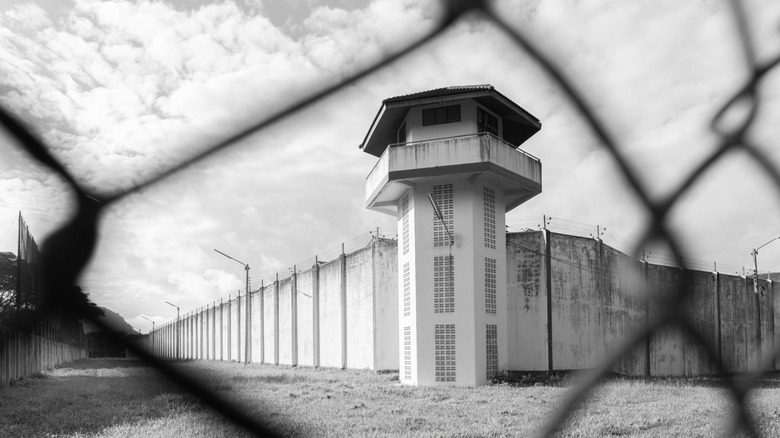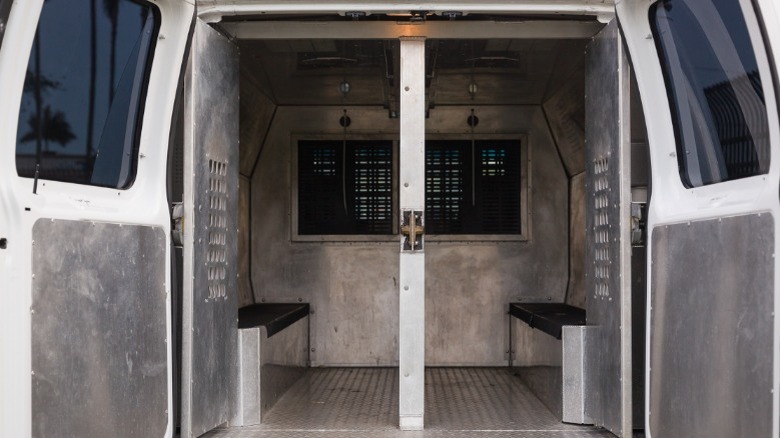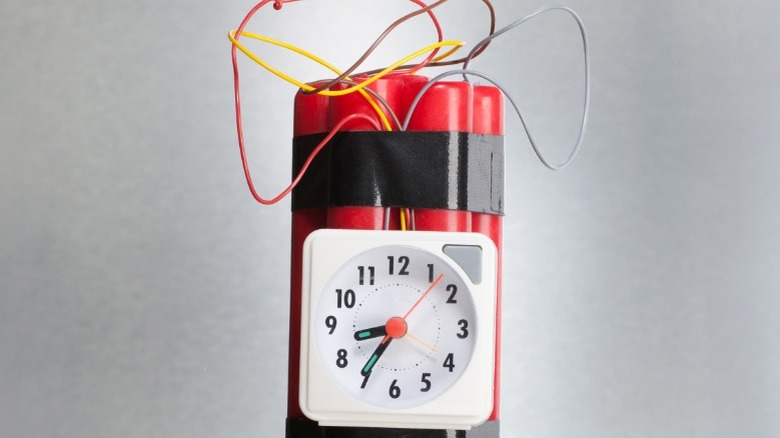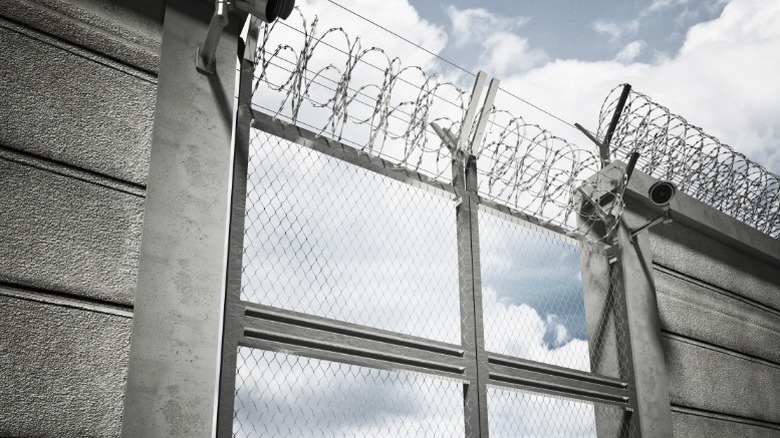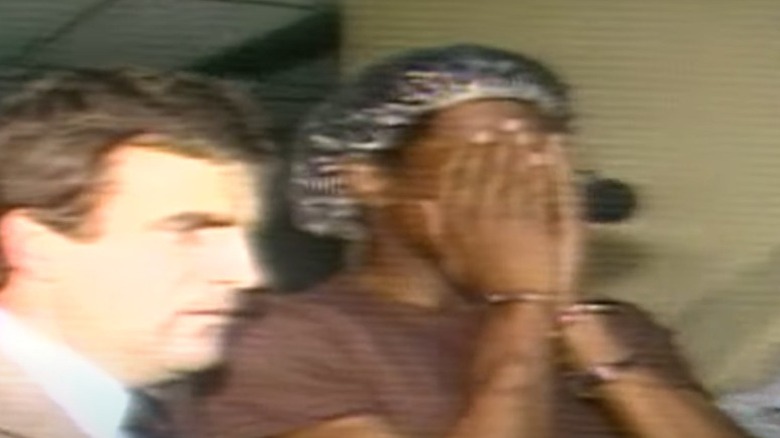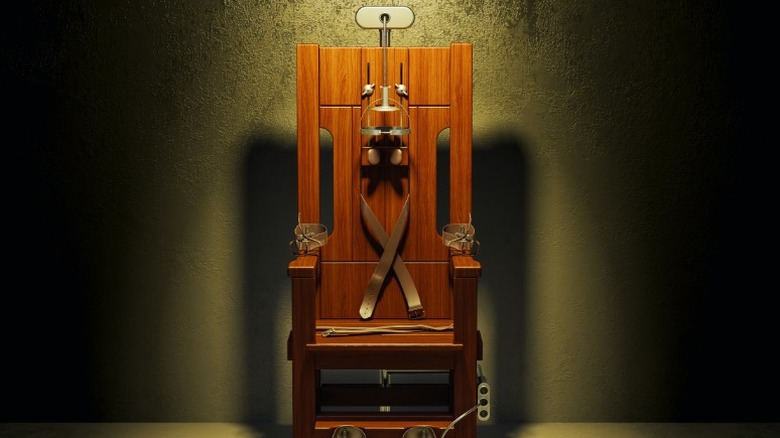The Briley Brothers' Escape From Death Row Involved A Bomb Threat And Three-Week Search
The prison was supposed to be escape-proof. When the Mecklenburg Correctional Center opened in the spring of 1977, Virginia Governor Mills E. Godwin was on hand to perform the ceremonial ribbon cutting. The event was a well-attended one. Throngs of reporters, local and state government officials, and area business leaders stood by and heard Godwin give a fiery speech on the importance this new facility held in being tough on crime. The governor referred to the prison that day as "a firm and lasting and unbreakable connection between crime and punishment" (per the Richmond Times-Dispatch). Little did he know that in seven years, the institution he hedged his bets on that day would become the location of the largest death row breakout in United States history.
On May 31, 1984, the Mecklenburg prison saw six of its detainees flee the grounds in a prison van. Earl Clanton Jr., Derick Peterson, Lem Tuggle Jr., Willie Leroy Jones, and Linwood and James Briley orchestrated an elaborate plan to make their way to freedom. The breakout sent shockwaves all up and down the east coast as six vicious killers were now on the loose. It took 19 days to round them all back up and required FBI and police officers from multiple jurisdictions as the escapees split up across different regions.
The details behind the breakout are still a fascinating study nearly 40 years later. A massive attack on guards, homemade weapons, and a fake bomb were all part of what must have been one of the most chaotic days in prison history.
The plan
The Briley brothers seemed to rule the death row units. Both had been part of a seven-month murder spree in 1979 that took at least 11 lives and had developed quite the network within Mecklenburg since they were first incarcerated (via the Richmond Times-Dispatch). Linwood and James gained the trust of several of the guards in their unit who were sympathetic toward them. They were unaware that these two men had been paying close attention to the procedural weaknesses within death row for the past several years and were slowly building an arsenal of homemade weapons to aid them in a future attack and escape. Several death row inmates, fearful of being harmed in the Brileys' upcoming escape attempt, alerted prison officials. A lockdown was instituted from April 1984 until the end of May but was allowed to expire due to pressures from bureaucrats and human rights watchers.
On the evening of May 31, the plan was put into action. Earl Clanton Jr. slipped out of line and locked himself in the bathroom, unnoticed by the guards. At 9 p.m., James Briley asked the lone guard in the control booth if he could get a book for him in the locked day room. When the guard opened the control room door, Clanton burst out of his hiding spot and attacked him. The control booth was now under inmate control, and all the doors in the unit were now unlocked.
Within a few minutes, the unarmed guards were overtaken in the unit by the inmates. They were stripped of their clothes, tied up, and forced into cells.
A fake bomb threat aided in the escape
Any time another guard would enter the unit, the inmates would attack them. Eventually, the officer the Brileys were waiting for made his way into the chaos. With a blade to his throat, he was made to call in a false report to other prison officials. As instructed, the lieutenant radioed in and gave some dire news to dispatch — he told them that the inmates had assembled a bomb and he needed to get it out of the prison before it detonated (per the Richmond Times-Dispatch). He ordered a guard to have an older model prison van sent to the back of the unit so that the bomb could be carried safely away.
The inmates, meanwhile, had put the next phase of their escape plan into action. They raided a closet and discovered the perfect disguises to go with their bomb ruse: riot gear. Dressed in guard uniforms that they took from their captives, the six inmates put on riot gear that concealed their facial features from anyone they might encounter. Then, they placed a television from the unit onto a stretcher and covered it with a blanket. They also snapped up a fire extinguisher to aid their deception.
When the prison van was backed into place, the six inmates emerged from the unit with the stretcher. Two of them were frantically using the fire extinguisher on the "bomb" that was underneath the blanket. They put the stretcher into the back of the van, and all six inmates climbed aboard.
The van was allowed to pass through the gates and out of the prison
To leave the prison grounds, two sets of gates needed to be opened. The guard who controlled them saw the Brileys and their accomplices load the fake bomb into the van but was hesitant to comply with their order of letting the van pass through. In the end, thinking that these men were guards, she relented, and the van carrying six dangerous murderers vanished into the night (per the Richmond Times-Dispatch).
The escaped cons had raided the pockets of the guards that they imprisoned in the death row unit. Together, they had amassed nearly $800 in cash, cigarettes, and several changes of clothing. The plan was to head north to Canada. The Canadian government is staunchly opposed to capital punishment and, as a matter of policy, will not extradite anyone who will be sent back to a county to be executed.
The manhunt was on. Before dawn, law enforcement agencies in multiple jurisdictions were on the lookout for the six men. The state police, who had been alerted the night of the escape, helped spread the word.
The escapees were all recaptured
Thankfully, the prisoners on the lam wouldn't stay out of custody for long. Earl Clanton Jr. and Derick Peterson were both apprehended the day after the breakout. The pair were both picked up in the town of Warrenton, not far from where the escape van had been left. Clanton was spotted and followed into a laundromat, while Peterson was cuffed after going into a convenience store (per The Washington Post). Lem Tuggle Jr. and Willie Leroy Jones almost made their way to Canada. And Tuggle might have made it had he not been careless during a store robbery at knife-point. He fled from the Woodford, Vermont shop and was caught after a short police chase. Jones was reported and arrested only 120 miles from the Canadian border.
The Briley brothers stuck together during their time on the run. Their freedom might have lasted longer if Tuggle hadn't cooperated with officials after his capture. He let authorities know that both brothers were dropped off outside of Philadelphia. The FBI knew from the Briley's prison files that they had family in Philly and began observation. After the prison guard uniforms were located in a tree, police knew they were on the right track. The big break came when a tapped line on a Briley brothers' acquaintance in New York showed a phone call from a Philadelphia garage. An officer on reconnaissance reported back that two men fitting the Briley's description were there, prompting nearly two dozen agents to swarm the location within hours. The brothers were barbequing chicken in the alley when approached and were arrested peacefully (via the Richmond Times-Dispatch).
All six were eventually executed
Both Linwood and James Briley took a seat in the electric chair mere months apart (per the Richmond Times-Dispatch). Linwood appealed his sentence to the United States Supreme Court but was turned away. He was executed on October 12, 1984, still maintaining his innocence (per UPI). James' execution followed on April 18, 1985. On the day he was to be led to the electric chair, fellow death row inmates staged a riot in hopes that they could delay the death of their fellow inmates. Though the violent event was not successful in that respect, the convicts did some substantial damage. Nine guards were injured in their wake.
Earl Clanton was next to die. His execution was carried out in April 1988 after he had exhausted all of his appeals. The Associated Press reports that he expressed remorse for the 1980 murder before he was led to his doom. Derick Peterson's execution followed in August 1991 (via the Richmond Times-Dispatch).
Willie Leroy Jones, who was given the death penalty for the murder of an elderly couple, sat in the hot seat in September 1992 (per The Washington Post). Virginia Governor L. Douglas Wilder turned down Jones' appeal for clemency in the 11th hour, dooming any hopes Jones had for a stay of execution.
The last of the six to die was Lem Tuggle. The convicted murderer chose lethal injection and had his veins filled with the deadly cocktail of drugs on December 12, 1996. As he entered the execution chamber, he screamed "Merry Christmas!" at the onlookers who had gathered. Those were his final recorded words.
